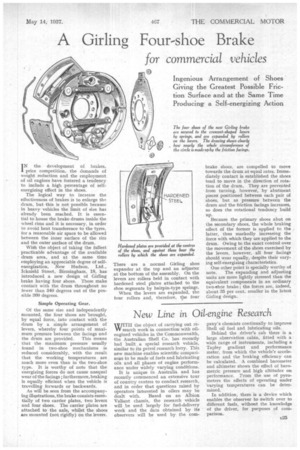A Girling Four-shoe Brake
Page 35

If you've noticed an error in this article please click here to report it so we can fix it.
for commercial vehicles
I N the development of brakes, price competition, the demands of weight reduction and the employment of oil engines have fostered a tendency to include a high percentage of selfenergizing effect in the shoes.
The logical way to inctease the effectiveness of brakes is to enlarge the drum, but this is not possible because in heavy vehicles the limit of size has already been reached. It is essential to house the brake drums inside the wheel rims and it is necessary, in order to avoid heat transference to the tyres, for a reasonable air space to be allowed between the inner surface of the rim and the outer surface of the drum.
With the object of taking the fullest practicable advantage of the available drum area, and at the same time employing an appreciable degree of selfenergization, New Hudson, Ltd., Icknield Street, Birmingham, 18, has introduced a new design of Girling brake having four shoes. These make contact with the drum throughout no fewer than 340 degrees out of the possible 360 degrees.
Simple Operating Gear.
Of the same size and independently mounted, the four -shoes are 'brought, by equal force, into contact with the drum by a simple arrangement of levers, whereby four points of maximum pressure between the facings and the drum are provided. This means
. that the maximum pressure usually found in two-shoe mechanisms is reduced considerably, with the result that the working temperatures are much more even than in the two-shoe type. It is worthy of note that the energizing forces do not cause unequal wear of the facings ; furthermore, braking is equally efficient when the vehicle is travelling forwards or backwards.
As will be seen from the accompanying illustrations, the brake consists essentially of two carrier plates, two levers and four shoes. The carrier plates are attached to the axle, whilst the shoes are mounted (not rigidly) on the levers. There are a normal Girling shoe expander at the top and an adjuster at the bottom of the assembly. On the levers are rollers held in contact with hardened steel plates attached to the shoe segments by hairpin-type springs. When the levers are expanded, the four rollers and, therefore, the four brake shoes, are compelled to move towards the drum at equal rates. Immediately contact is established the shoes tend to move in the direction of rotation of the drum. They are prevented from turning, however, by abutment pieces positioned between each pair of shoes, but as pressure between the drum and the friction facings increases, so does the rotational tendency build up.
Because the primary shoes abut on the secondary shoes, the whole braking effect of the former is applied to the latter, thus markedly increasing the force with which they are applied to the drum. Owing to the exact control over the movement of the shoes exercised by the levers, however, all four facings should wear equally, despite their varying self-energizing characteristics.
One other point is specially worthy of note: The expanding and adjusting units are more lightly stressed than the equivalent components in .an ordinary two-shoe brake ; the forces are, indeed, about 35 per cent, smaller in the latest Girling design.




















































































